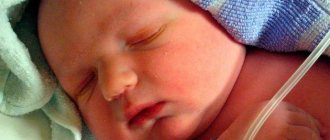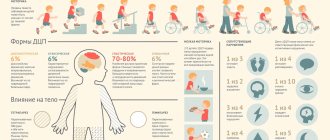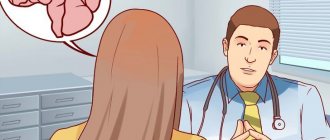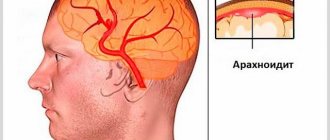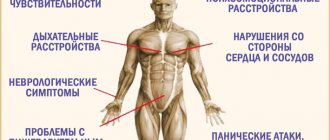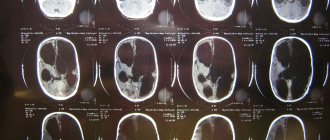Causes
The exact causes leading to the development of neurodegenerative diseases of the brain have not currently been identified. Most experts tend to consider the following as grounds:
- Genetic predisposition. Many neurodegenerative diseases are hereditary.
- Vascular disorders: abnormal location, damage to the vessel wall with changes in blood flow.
- Past viral infection. Exposure to infectious agents often causes disruption of the structure of nervous tissue with the death of neurons. Such pathologies include encephalitis, syphilis and HIV infection with neuropathy.
- Traumatic and mechanical damage to brain structures, including concussion. The most dangerous consequences are cystic formations, tumors and hemorrhages. These factors often cause dementia.
- Presence of intoxication. A single and powerful toxic effect, as well as the regular supply of small dosages of harmful components to brain cells, causes disruption of structures with a deterioration in their functioning. The most dangerous are free radicals, pesticides, as well as drugs and tobacco.
- Tumor processes of a malignant nature lead to neurological changes that cause loss of functions such as vision, hearing or speech.
Read about amyotrophic lateral sclerosis: signs and treatment.
Everything about cerebral toxoplasmosis: pathogen, symptoms, therapy.
Predisposing factors that increase the risk of developing neurodegenerative diseases of the nervous system include:
- obesity;
- endocrine changes, including pathologies of the hypothalamus and pituitary gland;
- addictions: alcohol, smoking, drugs;
- low level of intellectual activity;
- functional failure of the liver and kidneys with difficulty eliminating toxins.
Neurodegenerative diseases in children are extremely rare, so experts classify these pathologies as diseases of older age.
Neurodegenerative diseases: not just for the elderly
It is generally accepted that these pathologies, as well as neurodegenerative diseases in general, are the lot of older people. However, there are many cases where both diseases begin at a young age, literally as soon as the brain stops growing.
And it is in youth that hyperprolactinemia mainly develops, a pathology in which too much of the hormone prolactin is produced. The death of neurons in this disease causes inhibition of reproductive function, infertility, and at an advanced stage the disease provokes a pituitary tumor.
There are two groups of neurodegenerative diseases: sporadic and irritative. Sporadic diseases include Alzheimer's disease, multiple system atrophy, parkinsonian dementia, progressive supranuclear palsy, and dementia with Lewy bodies.
Irritative diseases include Wilson-Konovalov's disease, Hallervorden-Spatz's disease, Fahr's disease, Bessen-Kornzweig's disease and Gettington's chorea.
Symptoms of neurodegenerative diseases
Signs of neurodegenerative changes vary and largely depend on the causes that cause them. Among the main diseases with a typical clinical picture are:
- Alzheimer's disease. The disease manifests itself as a memory disorder in the form of memory loss and the inability to carry out mental operations. As a result of the progression of memory disorders, the patient is faced with the inability to care for himself, work and perform simple functions. Problems arise with writing words, pronouncing them, and reading. A person does not orient himself in the familiar space around him and does not understand the purpose of objects. Severe stages of Alzheimer's disease require constant monitoring of the patient.
- Parkinson's disease. The disease is caused by the death of nerve cells. As a result, the patient experiences constant tremors of the limbs, which disappears only during sleep. Rigidity of muscle fibers occurs with their tension and contraction. Movements become slower, and a person may experience inconvenience in performing everyday activities. Due to postural instability, there is a problem with maintaining balance, as a result of which patients often fall.
- Multiple sclerosis. The pathology diffusely damages the entire central nervous system. As a result of its development, a constant feeling of fatigue, malaise, as well as loss of balance and speech impairment appears.
- Huntington's disease. The disease often does not manifest itself in the initial stages. Patients experience the development of erratic and uncontrolled movements, as a result of which they change their facial expressions and habitual postures. Cognitive and psychological disorders lead to depression, memory impairment, inability to reproduce speech and remember various events. This leads to severe dementia.
- Progressive supranuclear palsy. The disease is quite rare. The pathology manifests itself in a clinical picture similar to Parkinson's disease: impaired coordination and movement, dysarthria, dysphagia, sleep disorder. A distinctive feature compared to Parkinson's disease is the lack of effect of Levodopa.
Treatment
Neurodegenerative diseases are classified as incurable. Even if the cause is eliminated, the consequences are irreversible. All drugs designed to destroy harmful proteins in the brain are under development.
However, such patients should be carefully monitored. They are constantly examined and take various medications to relieve symptoms and slow the progression of the disease.
Treatment of neurodegenerative diseases has its own characteristics:
- At the same time, it is necessary to treat somatic diseases. Patients require constant care and support. It is not recommended to leave them alone and isolate them from society, as this will only worsen the course of the disease. Social support and psychological assistance are an indispensable part of comprehensive treatment.
- Drug treatment depends on the specific disease and the cause of its occurrence. For example, in case of vascular dementia, medications are necessarily prescribed to strengthen blood vessels and normalize blood pressure. Also, for neurodegenerative diseases, nootropics (to improve brain nutrition) and antipsychotics (sedatives) are prescribed.
- Depression often accompanies dementia. In Parkinson's disease, at a certain stage, suicidal tendencies arise. For this reason, antidepressants are prescribed for neurodegenerative diseases. However, these drugs have many side effects. They are selected and adjusted as treatment progresses.
- In the initial stages, it is important to maintain a certain mental load. Patients perform various exercises to train memory and thinking. This helps slow down the progression of the disease.
- It is important to monitor the patient's diet. Neurodegenerative diseases are accompanied by various disorders of the digestive and excretory systems; patients' appetite worsens, and bulimia may develop. If this is a bedridden patient, he must be fed on time, excluding foods that can cause intestinal obstruction.
Of course, it is impossible to cure such serious diseases accompanied by dementia with folk remedies. Moreover, they cannot replace medications. But it has been proven that certain herbs can slow down the process of memory loss. They can be included in complex treatment. Such herbs include alcohol tinctures of ginseng, lemongrass, and Leuzea.
Diagnostics
Most neurodegenerative brain diseases are asymptomatic for a long time. In addition, early manifestations are often difficult to differentiate from other pathologies with similar symptoms.
The diagnosis begins with a conversation between the patient and the doctor. The specialist finds out not only the main complaints, but also the timing of the appearance of clinical signs and the rate of their increase. An external examination is carried out with a thorough identification of pathological reflexes. The doctor determines the necessary studies.
Laboratory methods that can detect abnormal changes: anemia, leukocytosis, positive reaction to syphilis or human immunodeficiency virus particles. Severe chronic abnormalities that cause toxic effects on the brain are manifested in biochemical studies.
Read about focal brain lesions: causes, symptoms.
Learn about the manifestations of cerebellar atrophy and treatment of the pathology.
Everything about brain atrophy: causes of development, main manifestations and treatment of the disease.
Instrumental methods:
- X-rays can reveal violations of the integrity of the skull, space-occupying formations or tumors of an endocrine nature;
- electroencephalography allows you to determine the functional state of the brain, as well as the transmission of nerve impulses;
- computed tomography and magnetic resonance imaging reveal early changes in the structure, as well as the degree of involvement of surrounding tissues.
Classification of these slowly progressing diseases
Based on the characteristics of the occurrence and mechanism of development of these diseases, they are usually divided into several groups: Tauprotein pathology.
- Synucleopathies.
- Trinucleotide hereditary diseases.
- Prion diseases.
- Motor neuron diseases.
- Group of neuroaxonal dystrophies.
Tauopathies arise as a result of disruption of the phosphorylation processes of tauprotein, which is able to be fixed in brain cells, thereby leading to disturbances in their function. The most common disease is Alzheimer's disease.
According to the features of pathogenesis, synucleopathies have a certain similarity with tauopathies, however, in this case, problems arise with another protein - alpha-synuclein. This is an insoluble protein that, when deposited in brain cells, leads to disruption of its functions.
Trinucleotide diseases are hereditary diseases that are characterized by an increase in the number of trinucleotide repeats.
Prion diseases are a separate group of infectious agents that do not contain nucleic acids. Prions are nothing more than proteins with an abnormal structure that are capable of converting normal proteins of the human body into similar compounds.
Motor neuron lesions. With this pathology, nerve cells that provide movement are drawn into the pathological process. In this case, both central motor neurons and peripheral ones can undergo degenerative changes.
The most well-known disease of this group is amyotrophic lateral sclerosis.
The group of neuroaxonal dystrophies is represented by relatively rare hereditary diseases.
Diseases of the spine and neuralgia
Osteochondrosis is a common occurrence in older people. Age-related pathological changes in the bone and cartilage structure lead to instability of the spine. This is often accompanied by pinching of the spinal nerve root. An older person may experience severe pain not only in the back. Manifestations of osteochondrosis are often confused with diseases of the upper and lower extremities and internal organs. Both a neurologist and an attentive therapist can make the correct diagnosis.
Neuralgia
is a nerve pathology caused by various reasons
It can develop against the background of viruses, muscle spasms, etc.
accompanied by pain in any part of the body.
Neuroaxonal dystrophies, as well as motor neuron pathology
The most famous of the motor neuron diseases is amyotrophic lateral sclerosis. Motor neurons in this disease are affected both in the cerebral cortex and in the spinal cord. This leads to paralysis, which also causes muscle atrophy over time.
The disease develops gradually, with patients first having to resort to assisted breathing equipment during sleep, and later to a ventilator. The only drug that has any effect is Riluzole, but it can only slightly slow down the progression of the disease. There is no etiotropic treatment.
Neurodegeneration with iron deposition in the brain is a representative of the group of neuroaxonal dystrophies. In this rare disease, symptoms are caused by iron deposits in the brain tissue.
The disease manifests itself as walking disorders, which are later joined by other movement disorders, as well as mental disorders. As with other diseases, treatment is symptomatic.
Clinic, diagnosis and treatment of tauopathies
Among the diseases of this group it is worth highlighting the following pathologies:
- Alzheimer's disease.
- Corticobasal degeneration.
- Pick's disease.
Of the tauopathies, the most widespread is Alzheimer's disease, which begins with subtle manifestations such as memory deterioration and the speed of assimilation of new knowledge and skills, ending with gross impairment of cognitive functions with loss of the ability to self-care.
The diagnosis is established based on characteristic symptoms, as well as on the basis of neuroimaging methods such as magnetic resonance imaging. There are few drugs used to treat this pathology - several drugs from the group of cholinesterase inhibitors and one drug from the group of NMDA antagonists.
Despite the treatment, the average life expectancy of such patients is about seven years.
Pick's disease is characterized by atrophy of the cerebral cortex, especially the temporal and frontal lobes. The symptoms are similar to those of Alzheimer's disease, but this disease is more malignant and less treatable.
Therapy is exclusively symptomatic; if indicated, antipsychotics are used.
With corticobasal degeneration, atrophy of the cerebral cortex is also observed, but in a slightly different location. This pathological process primarily affects the basal ganglia and substantia nigra. Hypokinetic-rigid syndrome, sensory function disorders, myoclonus, as well as a number of other manifestations are characteristic, which are usually used to establish the diagnosis (a puncture is usually not performed).

